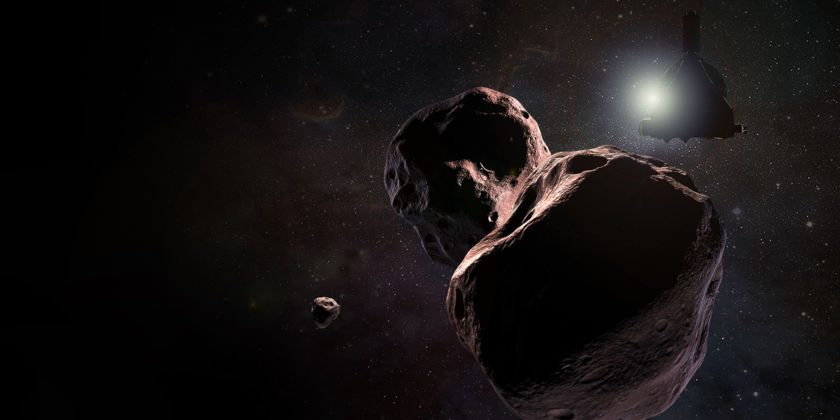

NASA’s New Horizons spacecraft made a big splash in 2015, when the little piano-sized spacecraft finally finished a nine-year journey that took it all the way to Pluto—the first time a human-made object encountered the dwarf planet. But New Horizons’ mission was far from over. Hurtling through space at well over 30,000 miles per hour, the spacecraft has continued on toward the outer reaches of the solar system’s Kuiper belt, and it’s about to deliver a wonderful New Years gift to us.
Get ready to meet 2014 MU69 (unofficially known as Ultima Thule), an object a billion miles beyond Pluto and 4.1 billion from Earth itself. On January 1, at around 12:33 a.m. Eastern Time, New Horizons will get to within 2,200 miles away from MU69—which sounds like quite a distance, but is actually three times closer than how far the spacecraft was from Pluto during its 2015 flyby (when it managed to capture many stunning images). New Horizons will be able to snap a ton of brand new, detailed shots and collect a slew of data poised to help us understand what exactly MU69 is, and what it can tell us about objects residing in such a far rim of the solar system.
“The Ultima Thule flyby is going to be fast, it’s going to be challenging, and it’s going to yield new knowledge,” Alan Stern, the principal investigator for the New Horizons mission, wrote in a blog post. “Being the most distant exploration of anything in history, it’s also going to be historic.”
There’s plenty for us to learn. We don’t know much about MU69—in fact, we didn’t even know it existed until June 2014. Three separate attempts to study it using telescopes have yielded very little insight. What we do know so far is that it’s about 20 miles in diameter (100 times smaller than Pluto), likely has a two-lobe shape (and may, in fact, be two separate rocks traveling together), has an orbit around the sun that goes for more than 295 years, emits a red hue, and is surrounded by millions of cold fragments thought to originate from the birth of the solar system 4.5 billion years ago. The Kuiper Belt is too cold and distant from the sun to encourage much in the way of planet formation, so many of its residents have essentially remained frozen in time for billions of years. They could regale for us an unheard history of the solar system and its planets, potentially shedding light into the conditions that helped lead to the evolution of a habitable world like Earth.
Most of these objects are too small to concretely study, but not MU69. Although it’s tiny compared even to dwarf planets, it’s still large enough to image closely and observe. The instruments onboard New Horizons can tell us whether MU69 has an atmosphere, rings, satellite objects of its own, any unusual elements or compounds embedded in the surface, and more. New Horizons has already been watching MU69 intently as it makes its way toward the object, and it has already raised a few investigative questions scientists are dying to answer, such as the cause of a strange light curve created by the object.
Still, the flyby won’t be an easy task to pull off. MU69’s small size and New Horizons’ staggeringly-high velocity means the flyby has to go just right—we won’t get a chance to simply loop back around and try again. Nor will there be an opportunity to fix things on the fly if we run into problems: It takes six hours for signals to go one way between New Horizons and Earth. We won’t know whether the flyby actually went as planned until well after there’s anything we can do about it.
But as was the case with the Pluto portion of New Horizons’ mission, we won’t have to wait long to see for ourselves what MU69 really looks like. NASA will ready the first high-resolution image of the object for release on January 2, and there will be many, many more images to follow in the weeks and months afterward.
If you’re already planning to stay up late to ring in the New Year, you can tune into NASA’s livestream of the flyby to follow the action. Expect to find out more about this mysterious rock as news trickles in over the first days of 2019.
